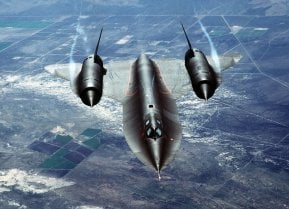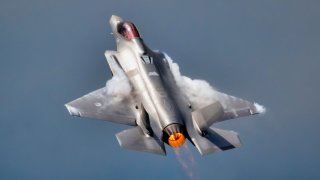Can the F-35 Dogfight? That Might End Up Being a Stupid Question
If the predictions are true, if dogfighting is indeed on the way out, then the F-35 will have been presciently built – with an emphasis on situational awareness, long-range engagement, and stealth.
The Lockheed Martin F-35 Joint Strike Fighter is world history’s most expensive defense project ever.
Over the lifetime of the program, taxpayers are expected to shell out $1.7 trillion for the stealth jet.
Accordingly, public scrutiny of the program has been intense, with the F-35 facing criticism that a lesser, cheaper weapons program may have avoided.
The criticism is appropriate. If taxpayers are going to pay a thirteen-figure price tag for a plane, that plane should be scrutinized and when warranted, criticized.
The criticisms facing the F-35 have varied. Often, the criticisms have targeted the costs of the program and the timeline of the program, underscoring a central question: do we need this thing?
And still, one criticism cut a little deeper, calling into question the F-35’s performance, suggesting that the $1.7 trillion had been invested on a lemon. The criticism is the assertion that the F-35 is a lousy dogfighter.
That's a big statement, and we need to explore it.
F-35: A Lousy Dogfighter?
In 2015, War is Boring obtained a five-page brief about the F-35’s dogfighting abilities. A pilot with first-hand knowledge had written the report – and his insights were unflattering.
“The F-35 was at a distinct energy disadvantage,” the pilot wrote, meaning that the F-35 “can’t turn or climb fast enough to hit an enemy plane during a dogfight or to dodge the enemy’s own gunfire,” War is Boring reported.
The F-35 pilot’s report was written in response to a test flight made on January 14th, 2015, over the Pacific Ocean near Edwards Air Force Base. The F-35 pilot flew an F-35A (the Air Force variant) alongside two F-16D Block 40’s – a fourth-generation jet that the F-35 was designed to eventually replace. The test was built to gauge the F-35’s effectiveness at Air Combat Maneuvering (ACM), more commonly known as dogfighting.
“The evaluation focused on the overall effectiveness of the aircraft in performing various specified maneuvers in a dynamic environment,” the F-35 pilot wrote. “This consisted of traditional Basic Fighter Maneuvers in offensive, defensive and neutral setups at altitudes ranging from 10,000 to 30,000 feet.”
For the test, the F-35 flew “clean,” meaning it did not carry any weapons, which could have slowed the jet down. The F-16s, meanwhile, were carrying bulky drop tanks. Yet, regardless of the aerodynamic advantage, the F-35 performed poorly. “The stealth fighter proved too sluggish to reliably defeat the F-16, even with the F-16 lugging extra fuel tanks,” War is Boring reported.
According to the F-35 pilot, the new jet suffered from “insufficient pitch rate” and “lack of nose rate,” noting that the “energy deficit to the bandit would increase over time” and that “the flying qualities in the blended region (20-26 degrees [angle of attack] were not intuitive or favorable.”
“The F-35 pilot came right out and said it,” War is Boring reported, “if you’re flying a JSF, there’s no point in trying to get into a sustained, close turning battle with another fighter.”
Pierre Spray, who helped push for the development of the F-16, came out with a scathing criticism of the F-35, calling the stealth jet a “turkey.”
“It’s an inherently a terrible aircraft,” Spray said. “It’s a dumb idea to go for a multi-mission aircraft. You have something that’s supposedly a close-support, a deep interdictor, a bomber, and an air-to-air fighter. You’ve compromised the aircraft right there: then you saddle it with the bureaucracy of three services; the USAF, the US Navy, and the US Marines. The thing has no wing so it can’t turn, it’s got a fat fuselage to house a lifting fan for the vertical landing that the Marines want in the specification. In dogfighting it's hopeless. A 1950s Mirage of MiG-21 could whip the F-35.”
But That F-35 Report Had Some Big Flaws
However, we discovered years later that the F-16 vs. F-35 test had a significant flaw: the F-35 used was not fully 'combat-coded' for such a scenario.
Former National Interest Defense Editor Kris Osborn spoke to an F-35 pilot years ago who was at the simulation and presented a lot of information that was unknown at the time.
“I was at Edwards Air Force Base when the test pilots were there and they were writing that original report. It’s been the narrative ever since and I want to say a few things about that. . . . First of all, it should be noted the aircraft (F-35) was in its infancy stages and we were still just trying to learn how to fly the airplane,” Chris “Worm” Spinelli, an F-35 test pilot for Lockheed Martin, told the National Interest several years ago.
“The entire CLAW [Flight Control Laws] hadn’t been delivered yet so the guys hadn’t really developed tactics, techniques, and procedures, etc. So to say that the F-35 can’t Basic Flight Maneuver [a term for dogfight], I think, is a gross overstatement. Honestly, you know I think it would be quite eye-opening to see an F-35 and an F-16 in a BFM engagement, depending on how it was managed. Certainly, the F-35 has some advantages that the F-16 does not, particularly in its helmet integration, along with its advanced weapons, which are a lot more beneficial in platforms like the F-22 or F-35.”
Indeed, in a statement from the F-35 Joint Program Office back in 2015 obtained by Osborn, it noted that: “[T]he media report on the F-35 and F-16 flight does not tell the entire story,” the F-35 JPO office stated. “The F-35 involved was AF-2, which is an F-35 designed for flight sciences testing, or flying qualities, of the aircraft. It is not equipped with a number of items that make today's production F-35s 5th Generation fighters.”
It went on to state that the AF-2 was “not equipped with the weapons or software that allow the F-35 pilot to turn, aim a weapon with the helmet, and fire at an enemy without having to point the airplane at its target.”
F-35 Means A New Era
Whether the F-35 will be required to dogfight is unclear. With the onset of fifth-generation technology, whether dogfights will continue to be a facet of aviation combat at all is unclear. But warfighters have been predicting the demise of dogfighting for generations. The onset of jet propulsion was supposed to eliminate the dogfight. The onset of long-range missiles, too, was supposed to eliminate the dogfight. Yet, the dogfight persisted, as a relevant scenario in aviation combat, through the introduction of jet engines and missiles. Now, stealth technology paired with improved long-range sensors and BVR weapons is predicted to signal the end of dogfighting.
If the predictions are true, if dogfighting is indeed on the way out, then the F-35 will have been presciently built – with an emphasis on situational awareness, long-range engagement, and stealth.
About the Author
Harrison Kass is a defense and national security writer with over 1,000 published pieces. An attorney, pilot, guitarist, and minor pro hockey player, Harrison joined the US Air Force as a Pilot Trainee but was medically discharged. Harrison holds a BA from Lake Forest College, a JD from the University of Oregon, and an MA from New York University. Harrison listens to Dokken.


